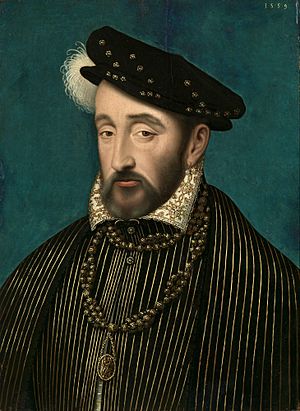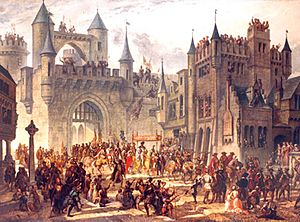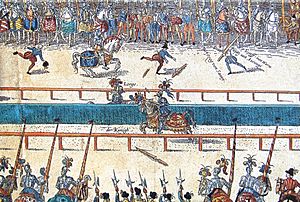Henry II of France facts for kids
Quick facts for kids Henry II |
|
|---|---|

|
|
| King of France (more...) | |
| Reign | 31 March 1547 – 10 July 1559 |
| Coronation | 25 July 1547 |
| Predecessor | Francis I |
| Successor | Francis II |
| Born | 31 March 1519 Château de Saint-Germain-en-Laye |
| Died | 10 July 1559 (aged 40) Hôtel des Tournelles |
| Burial | 13 August 1559 Saint Denis Basilica |
| Spouse | |
| Issue among others... |
|
| House | Valois-Angoulême |
| Father | Francis I of France |
| Mother | Claude, Duchess of Brittany |
| Religion | Catholicism |
| Signature |  |
Henry II (French: Henri II; 31 March 1519 – 10 July 1559) was the King of France from 1547 until his death in 1559. He was the second son of King Francis I and Duchess Claude of Brittany. Henry became the Dauphin of France (which means heir to the throne) after his older brother, Francis, died in 1536.
As a child, Henry and his brother were held captive in Spain for over four years. This happened as a way to secure their father's release from prison. As king, Henry continued many of his father's policies. He was involved in wars and tried to control the spread of the Protestant faith in France.
In 1559, a peace treaty called the Peace of Cateau-Cambrésis ended the long-running Italian Wars. France gave up its claims in Italy but gained new lands like Calais. This helped strengthen France's borders. The famous astrologer Nostradamus also served King Henry as a physician.
Sadly, in July 1559, Henry was badly hurt during a jousting tournament. He died ten days later. Even though he died young, he left behind four sons and his wife, Catherine de' Medici. Three of his sons later became kings. However, their reigns were not very strong. This, along with Catherine's rule, led to the French Wars of Religion. These wars were fought between Catholics and Protestants in France. They eventually led to the end of the House of Valois as France's ruling family.
Contents
Early Life of Henry II
Henry was born at the royal Château de Saint-Germain-en-Laye, near Paris. His parents were King Francis I and Claude, Duchess of Brittany. His mother, Claude, was the daughter of Louis XII of France. Henry's parents were cousins, and their marriage helped strengthen their family's claim to the French throne.
In 1525, Henry's father was captured in battle by the Holy Roman Emperor Charles V. To get his father released, Henry and his older brother Francis were sent to Spain as hostages. They stayed in captivity for more than four years.
Henry married Catherine de' Medici on October 28, 1533. They were both fourteen years old at the time. Catherine was from a powerful ruling family in Florence, Italy. At this point, Henry's older brother was still alive. So, it seemed unlikely that Henry would ever become king.
The next year, Henry became very close with Diane de Poitiers, a widow who was older than him. Diane had been kind to Henry when he was a child. She had hugged him before he left for Spain as a hostage. This strong bond continued after he returned to France. Diane was very confident and intelligent. She had a lot of influence over Henry. However, she also made sure that Henry and Catherine had children to secure the family line.
In 1536, Henry's older brother Francis died after playing a game of tennis. This meant that Henry suddenly became the heir to the throne.
Henry's close relationship with Diane caused some problems with his father in 1544. His father's mistress, Anne de Pisseleu, convinced King Francis that Henry and Diane were plotting against him. Because of this, Francis sent Diane away from court. Henry also left the court for a while. However, father and son made up in 1545.
Henry became king on his 28th birthday, March 31, 1547. He was crowned King of France on July 25, 1547, at Reims Cathedral.
Henry II's Time as King
Dealing with Protestants
Henry's time as king was known for the harsh treatment of Protestants. These were mainly Calvinists, also known as Huguenots in France. Henry II punished them severely. For example, he would burn them at the stake or cut off their tongues for speaking against the Catholic Church.
In April 1551, Henry II was made a Knight of the Garter by King Edward VI of England.
The Edict of Châteaubriant was issued in 1551. This law ordered courts to find and punish all Protestants. It also placed strict rules on Huguenots. For example, they could lose a third of their property to people who reported them. The Edict also controlled what books could be sold or printed. During Henry II's reign, Huguenots tried to start a colony in Brazil. This colony was called France Antarctique, but it did not last long.
Italian War of 1551–1559

The Italian War of 1551–1559 started when Henry declared war on the Holy Roman Emperor Charles V. Henry wanted to take back control of Italy. He also wanted France to be the most powerful country in Europe, not the Habsburgs. Even though he punished Protestants at home, he made an alliance with German Protestant princes in 1552. This was part of the Treaty of Chambord.
At the same time, Henry continued his father's alliance with the Ottoman Empire. This allowed him to invade the Rhineland. A combined French and Ottoman fleet also protected southern France. In 1552, Henry gained control of the Three Bishoprics of Toul, Verdun, and Metz.
In 1556, Charles V gave up his power. His empire was then split between his son Philip II of Spain and his brother Ferdinand I. Henry's conflict with the Habsburgs then moved to Flanders. There, Philip, along with Emmanuel Philibert, Duke of Savoy, defeated the French at the Battle of St Quentin. England joined the war later that year. This led to the French capture of Calais. French armies also attacked Spanish lands in the Low Countries.
However, by April 1559, France was running out of money. Also, religious tensions were growing at home. So, Henry agreed to the Peace of Cateau-Cambrésis.
This peace treaty was signed between Henry and Queen Elizabeth I of England on April 2, 1559. It was also signed between Henry and Philip of Spain on April 3, 1559. Under the treaty, France returned Piedmont and Savoy. But France kept Saluzzo, Calais, and the Three Bishoprics. To make the agreement stronger, Henry's sister Margaret married Emmanuel Philibert. His daughter Elisabeth of Valois became Philip's third wife.
Henry also raised the young Mary, Queen of Scots, at his court. He hoped to claim the throne of Scotland by marrying her to his son, Dauphin Francis. This marriage happened on April 24, 1558. Their son would have been King of France and Scotland. He would also have had a claim to the throne of England. Henry made Mary sign secret documents. These documents would ensure that the Valois family would rule Scotland even if Mary died without children by Francis. However, Francis died without children a year and a half after his father. This ended the French claim to Scotland.
New Ideas: Patent Innovation
Henry II introduced the idea of publishing details about new inventions. This was done in the form of a patent. The idea was that an inventor would share how their invention worked. In return, they would get special rights to be the only one to use or sell it for a certain time. This detailed description is called a patent "specification." The first patent specification was submitted by Abel Foullon. It was for a type of rangefinder. The details of this invention were not made public until after the patent expired in 1561.
Death of Henry II

Henry II loved hunting and taking part in jousting tournaments. On June 30, 1559, a tournament was held near Place des Vosges. It was to celebrate the peace treaty with his old enemies, the Habsburgs. It also celebrated the marriage of his daughter Elisabeth of Valois to King Philip II of Spain. During a jousting match, King Henry was wearing the colors of his close companion Diane de Poitiers. He was hit in the eye by a broken piece of a lance. The lance belonged to Gabriel Montgomery, who was the captain of the King's Scottish Guard.
Royal doctors tried to help him. But the king's eye and brain were badly damaged. He died from an infection on July 10, 1559. He was buried in a special tomb at Saint Denis Basilica. Henry's death played a big part in why jousting became less popular as a sport, especially in France.
As Henry was dying, Queen Catherine controlled who could see him. She did not allow his companion Diane de Poitiers to visit him, even though he asked for her. After Henry's death, Catherine sent Diane away from the court. Diane lived comfortably on her own properties until she died.
It was a tradition to place the king's heart in a special urn. The Monument to the Heart of Henry II is now in the Louvre Museum in Paris. The original bronze urn that held the king's heart was destroyed during the French Revolution. A copy was made in the 1800s. The marble sculpture of the Three Graces holding the urn still exists. It was made by Germain Pilon, a sculptor for Catherine de' Medici.
Henry was followed on the throne by his sickly fifteen-year-old son, Francis II. Francis was married to sixteen-year-old Mary, Queen of Scots. She had been his childhood friend. Francis II died in December 1560. Mary then returned to Scotland in August 1561. Francis II was succeeded by his ten-year-old brother Charles IX. Their mother, Catherine de Medici, ruled the country for him because he was too young.
Henry II's Children
Catherine de' Medici had ten children with Henry:
- Francis II, born January 19, 1544. He married Mary, Queen of Scots.
- Elizabeth of France, born April 2, 1545. She married Philip II, King of Spain.
- Claude, born November 12, 1547. She married Charles III, Duke of Lorraine.
- Louis, Duke of Orléans, born February 3, 1549. He died on October 24, 1550.
- Charles IX, born June 27, 1550. He died on May 30, 1574.
- Henry III, born September 19, 1551. He was also briefly King of Poland.
- Margaret, born May 14, 1553. She married Henry III, King of Navarre (who later became Henry IV of France).
- Hercules, born March 18, 1555. He was later known as Francis, Duke of Alençon and Anjou.
- Victoire, born June 24, 1556. She died on August 17, 1556.
- Joan, born June 24, 1556. She was stillborn.
Henry II also had three other children born outside of his marriage:
- With Filippa Duci:
- Diane, Duchess of Angoulême (1538–1619). She married twice.
- With Lady Janet Stewart (1502–1562), who was a daughter of James IV of Scotland:
- Henri d'Angoulême (1551 – June 1586). He was officially recognized and became governor of Provence.
- With Nicole de Savigny:
- Henri de Saint-Rémi (1557–1621). He was given the title of Count of Saint-Rémy. One of his later family members was Jeanne de Valois-Saint-Rémy. She was famous for her role in the Affair of the Diamond Necklace at the court of Louis XVI.
Henry II in Movies and TV Shows
Henry has been shown in several movies and TV shows:
- He was played by a young Roger Moore in the 1956 film Diane.
- In the 1998 film Ever After, the Prince Charming character, played by Dougray Scott, shares his name with Henry.
- In the 2013 CW series Reign, he is played by Alan van Sprang.
- In the 2022 series The Serpent Queen, a young Henry is played by Alex Heath. Later, an older Henry is played by Lee Ingleby.
Images for kids
-
Henry II, here standing on an oriental carpet, continued the policy of Franco-Ottoman alliance of his father Francis I. Painting by François Clouet.
-
"Bastard culverin" of 1548, with arms of Henri II and Catherine de Medicis and crescent of Diane de Poitiers. Caliber: 85mm, length: 300 cm, weight: 1076 kg.
-
A cypher machine in the shape of a book, with arms of Henri II.
-
Monument to the Heart of Henry II, Louvre, Paris, sculpture of the Three Graces by Germain Pilon holding a replica of the urn that contained the king's heart
See also
 In Spanish: Enrique II de Francia para niños
In Spanish: Enrique II de Francia para niños










